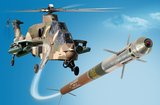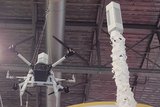Future US Army capabilities will be largely unmanned
A Project Origin experimental vehicle dispenses smoke during a Soldier Touchpoint at Fort Benning. (Photo: US Army)
The US Army foresees its future with a comprehensive inventory of unmanned capabilities and has been investing in various programmes within the realm. In its FY2025 budget proposal, it requested $1 billion for procurement and RDT&E efforts related to uncrewed systems, solutions and platforms.
The fund will enable acquiring diverse sizes and models of UAVs, progressing with the development of UGVs and increasing the use of autonomous electronic equipment.
“It is not about machines replacing humans,” claimed Gen James Rainey, commanding general of the US Army Futures Command. “It is how you optimise the two [humans and machines] so you
Already have an account? Log in
Want to keep reading this article?
More from Eurosatory 2024 | View all news
-
![India expands ammunition production with Adani–Thales collaboration]()
India expands ammunition production with Adani–Thales collaboration
Adani Defence & Aerospace has teamed up with Thales Belgium to manufacture and assemble NATO-standard 70mm calibre ammunition, strengthening India's self-reliance in defence production.
-
![Naval artificial intelligence demonstrated in new applications in Paris]()
Naval artificial intelligence demonstrated in new applications in Paris
The prevalence of AI-enabled solutions from startups and major defence company at this year’s Eurosatory highlighted both the potential benefits and trust-related challenges associated with its adoption.
-
![Thales completes delivery of upgraded command and staff trainer to Polish Land Forces]()
Thales completes delivery of upgraded command and staff trainer to Polish Land Forces
Thales unveiled its CAST system at Eurosatory 2024 showcasing its advanced capabilities in enhancing situational awareness and decision-making skills.
-
Sogitec combines Sword, Genius and HORUS for virtual/constructive demonstrator
The French company has integrated its Genius UAS and HORUS helicopter simulators with MASA’s Sword constructive simulation as it aims to achieve operational orders by the end of 2025.
-
![Saab releases details on Sirius Compact EW sensor]()
Saab releases details on Sirius Compact EW sensor
Sirius Compact can be operated as a stand-alone unit or as part of a network with several sensors typically supporting Ground Based Air Defence with target information.
-
![Thales takes new HF communications system from ship to shore]()
Thales takes new HF communications system from ship to shore
The HF XL family was unveiled at last month’s Eurosatory 2024 with the company pushing the system’s capability of searching out unjammed channels or channels with the highest data rate available.
























